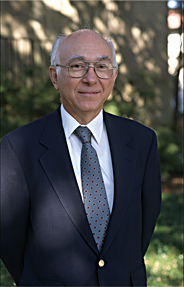History of the Landolt Astronomical Observatory
 The observatory on top of Nicholson Hall was first opened in 1939. The telescope is
a refracting telescope with the lens having a diameter of 11.5-inches. The maker of
the lens and the telescope was Alvan Clark & Sons. Clark was the premier maker of
refracting telescopes and indeed is universally acknowledged to be the world's all-time
best maker of refractor telescopes. LSU is lucky and proud to have such a classy instrument.
The observatory on top of Nicholson Hall was first opened in 1939. The telescope is
a refracting telescope with the lens having a diameter of 11.5-inches. The maker of
the lens and the telescope was Alvan Clark & Sons. Clark was the premier maker of
refracting telescopes and indeed is universally acknowledged to be the world's all-time
best maker of refractor telescopes. LSU is lucky and proud to have such a classy instrument.
Long-focus refractors give a high-quality high-magnification view that is perfect for looking at the Moon and planets. Wonderful amounts of detail can be seen on the planets, including volcanoes, polar caps and morning-fogs on Mars as well as Jupiter's Great Red Spot and fine divisions in Saturn's rings. For the Moon, we can see large and small craters, huge impact basins and low volcanic domes. The views are wonderful and make one think of flying low over the surface of the Moon. The 11.5" Clark telescope is also good for looking at double stars and bright nebulae around the sky.
From the late 1940's to the 1970's, the telescope was used for taking many astronomical photographs for various purposes including scientific studies. However, for scientific purposes, the telescope can no longer compete, as its aperture is too small and the light pollution from the city makes for a very bright sky.
From 1939 to the early 1990's, the telescope was used for regular Public Nights as
well as LSU classes of many types. Many people around Baton Rouge fondly remember
coming out to see the wonderful sights with this excellent scope. The growing light pollution
has little impact on visual views of the Moon and planets, as these are intrinsically
bright targets.
to see the wonderful sights with this excellent scope. The growing light pollution
has little impact on visual views of the Moon and planets, as these are intrinsically
bright targets.
In the early 1990's, the observatory fell into disuse and some disrepair. The causes
are just the normal ones that primary users retired and moved away, while its scientific
utility was lost. From the mid-1990's until 2005, the observatory was essentially
unused with the dome getting in poor shape. But the Clark telescope and lens do not
'decay', so in 2005 a group in the Physics and Astronomy Department worked long hours
repairing and refurbishing the telescope. Most of this was in scraping and repainting
everything, polishing the brass tube, replacing the doors and windows, and making
a variety of repairs. The Clark lens was untouched. So finally, in early November
2005, the Department had a Grand Reopening with a Public Night at the time of Mars's
closest approach. After almost two decades of inactivity, the Clark telescope is again
showing beautiful views of the sky to students and Baton Rouge residents.
At the time of the Grand Reopening, it was realized that the observatory did not have
a name. The obvious name for the observatory was to honor Professor Arlo U. Landolt (1935-2022) for long being the core of the astronomy program at LSU. With his long
years of serving as the Secretary of the American Astronomical Society, Dr. Landolt
is among the most recognizable of American astronomers. His long work at providing
standard stars (used for calibrating photometry as is vital for ~10% of modern astronomy)
is among the most-cited papers in all astronomy. Given his long and very strong contributions
to LSU astronomy, American astronomy, and world astronomy; it is appropriate to dedicate
the observatory as the "Landolt Astronomical Observatory" as a small recognition of
his work.
LSU Mourns the Loss of World-Renowned Astronomer Arlo U. Landolt
